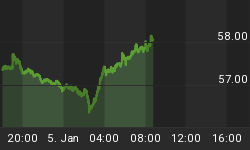Under the stewardship of Shinzo Abe, the nation of Japan has become a global leader in debt, currency devaluation and inflation. Unfortunately for the Japanese, Abenomics is also leading Japan into a hyperinflationary depression, as the first of his three arrows has shot right through the yen and put a gaping hole in the wallets of every Japanese citizen.
The Bank of Japan (BOJ) has placed all its chips on the bet that inflation will cure all the nation's economic problems. Making deflation public enemy number one is rather convenient when your country's public debt to GDP is the highest in the world. In order to end deflation, the central bank has purchased 70% of all newly-issued Japanese Government Bonds. All this money printing is intended to get prices rising, and it has been very successful. Japan's consumer prices rose 3.1 percent in August from a year earlier. Prices for fuel, light and water rose 6.4 percent on the year. But as real wages continue to fall, the bull's eye appears to be directed on destroying the Japanese middle class.
In the nonsensical world of Abenomics--where inflation is viewed to be the progenitor of growth--the 3.1% CPI reading is deemed to be insufficient. This is because the core rate of 1.1 percent was far shy of the 2% read they are aiming for. So, as expected, there are calls coming from the lobotomized economic experts in Japan for yet more money printing from the BOJ.
Japan's "experiment" with Abenomics would be much more interesting if we didn't already know how it all ends. This so called experiment of massive debt monetization has already been tried in countries such as Weimar Germany and, more recently, in Zimbabwe; with disastrous results. The misguided policy of using inflation to create growth is predictably causing asset bubbles in JGBs and stocks. The BOJ is tirelessly printing money to monetize nearly all of the Japanese government's enormous debt load and also to buy stocks. This has ballooned its equity portfolio alone to be an estimated 7 trillion yen ($63.6 billion). However, all this has done nothing to boost real GDP, balance trade or boost real wages. In fact, Industrial production shrank 1.5 percent month-on-month in August and spending among Japanese households fell a steeper-than-expected 4.7 percent.
The Japanese economy has reached the point of no return. The BOJ will continue to print yen until the citizens of Japan, unable to take any more pain from intractable inflation, insist on a change of course. The real solution for Japan will be to explicitly default on its monstrous debt.
The major beneficiary of Abenomics has been the value of the U.S. dollar. But this will not be the case for very much longer. There currently appears to be a trenchant divergence between the monetary policies of the BOJ, and that of the Fed. The market has become convinced that the Fed will soon be raising interest rates, while the BOJ continues to reckless print money. This has caused a large increase in the value of dollar vis-à-vis the Yen.
The dollar is going higher because of the misperception that the U.S. economy is strengthening. Markets are also convinced that the Fed will have a graceful exit from QE and a smooth transition to interest rate mean reversion. But this could not be further from the truth. The US economy is still highly susceptible to even slight interest rate hikes. This is why Q1 GDP was a negative 2.1 percent. The 10-year note went from 1.6% in May, to 3% by the end of 2013. Keynesians blamed snow for the negative first quarter, but the truth is that our over-indebted economy falls apart once debt service costs increase -- even from such low levels.
As the Fed exits QE and prepares the market for rate hikes, we see the Case-Shiller home price index fell 0.5% in July, the biggest drop since November 2011 and the third month in a row of such declines. The Russell 2000 is down 12% from its March highs, and half of the NASDAQ is in a bear market. Commodity prices are crumbling as the economic data is weakens. Pending home sales, the ISM Manufacturing Index, Construction Spending and Factory Orders all recently came in worse than expected.
QE's purpose was to boost real estate, equity and bond prices. After six years of successfully re-inflating assets, the Fed has duped itself and the markets into believing it can exit monetary manipulations with impunity. Therefore, get ready for the resumption of plummeting asset prices like we experienced in 2008.
But remember, central banks' number one fear is deflation. The Fed under Chairperson Janet Yellen is certainly not the exception, and she will do whatever is necessary to curtail the dollar's strength. This is why the Fed will not be aggressively hiking rates in 2015; and could even start another round of QE in the near future.
Much like the BOJ, our central bank firmly believes that inflation can somehow lead to prosperity. After asset bubbles crumble and the Fed re-engages, the true anemic state of the dollar will be revealed.
Most importantly, it is crucial to understand that the intrinsic value of the dollar is not rising. Real interest rates in the United States are still very much negative and the money supply is growing far faster than real GDP. Therefore, the dollar is only rising if measured against those countries whose central banks are actively trying to depreciate their currencies. And the U.S. Fed is about to rejoin in that effort.
Japanese citizens -- if they have any discretionary investment income left -- should be aggressively selling their paper money and buying gold. And it won't be long before all holders of fiat currencies are forced to do the same.















